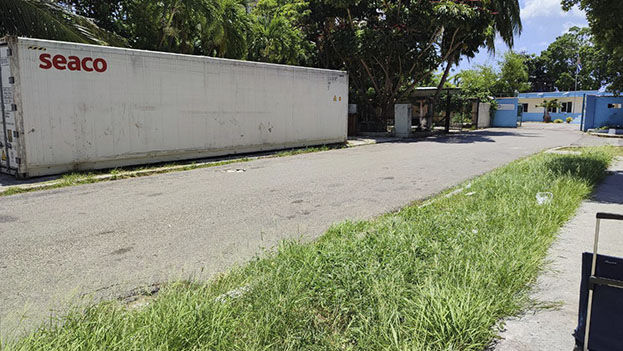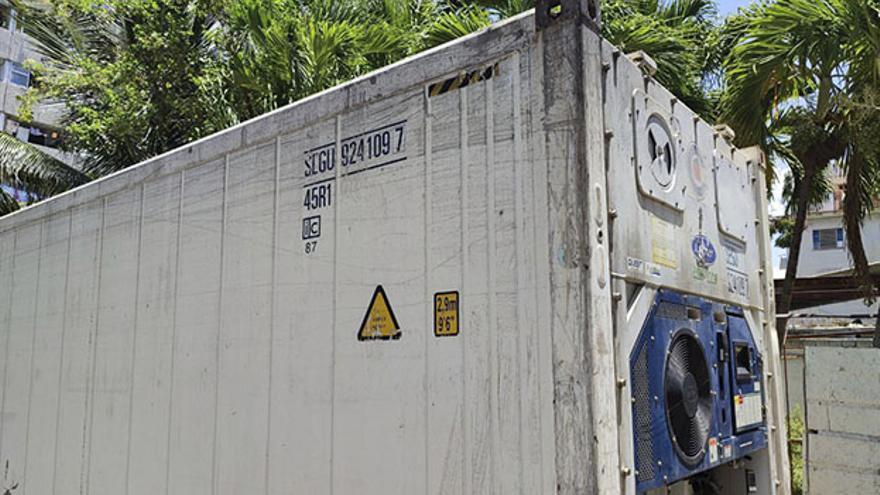
![]() 14ymedio, Yoani Sánchez, Generation Y, Havana, 12 August 2023 – Huge, refrigerated and with seals that reveal its journey through the seas of the world, this is the container that has arrived in our Havana neighborhood. The elongated mass has become, in a few days, the center of rumors, hopes and criticism. “It belongs to a small private business owner who brought it to sell frozen chicken,” a neighbor tells me. “It will also offer sausages, soft drinks and beers,” says a pensioner who lives right across from the container. “I’m sure it will put prices through the roof,” speculates another old woman.
14ymedio, Yoani Sánchez, Generation Y, Havana, 12 August 2023 – Huge, refrigerated and with seals that reveal its journey through the seas of the world, this is the container that has arrived in our Havana neighborhood. The elongated mass has become, in a few days, the center of rumors, hopes and criticism. “It belongs to a small private business owner who brought it to sell frozen chicken,” a neighbor tells me. “It will also offer sausages, soft drinks and beers,” says a pensioner who lives right across from the container. “I’m sure it will put prices through the roof,” speculates another old woman.
In an area with numerous buildings of more than 12 floors and few supermarkets, the Seaco brand container has been placed on the sidewalk a few yards from the Factor y Final Immigration and Alien Office, a place feared for having a jail for foreigners and a processing center for deportees. “You have to have a lot of courage to put something like this in the face of ‘these people’,” says one of the young men who spends most of his days on the bench in a nearby park. “It has to be a someone with pull, an ex-military man,” he concludes.
In a short time, all kinds of legends have been woven around the deposit. What is being said shows much of the apprehensions and hopes of Cubans with micro, small and medium-sized companies [MSMEs], authorized just a couple of years ago. There are those who believe that when the box’s doors open, they will no longer have to travel to Centro Habana or El Vedado to buy a package of frozen chicken. “It will be expensive but at least it will be close,” a former microbrigadista [micro-brigade member] who helped build our concrete block tells me with relief.
The container has also increased the animosity. Its gleaming appearance stands very close to the rationed market’s butcher shop, whose refrigeration broke years ago and whose supplies are dwindling, with its long line of people with long faces and poor wages. “Retirees won’t be able to buy there,” concludes a woman who tries to survive exclusively on her pension of 1,400 pesos a month. Without relatives abroad or illegal businesses, the woman has no chance of paying an MSME more than 1,200 CUP for a kilogram of milk.
Although there are places in the area that once functioned as stores that took payment in convertible pesos and, previously, as markets for products that arrived from Eastern Europe during the days of Soviet subsidy, no one puts their hopes in these shops anymore. People know that now the most dynamic sale and the one with the greatest variety on offer is the one that is done in a corner, on the sidewalk, in an improvised kiosk or from the truck itself. The Cuban economy has come to center on these containers.

“I am selling a container of vegetable oil,” “Place your orders now fpr the container that will arrive in the second half of August,” “We offer a professional transfer service for your container to any part of Havana,” “No retail, purchase the full container or there is no deal,” are phrases that are read on Facebook groups, on classified ad sites and on WhatsApp lists where imported goods are promoted. The store experience: grabbing the cart, strolling through the shelves and choosing the product has become superfluous. Goods are bought blind, most of the time in closed boxes that list the weight on the outside, with some phrases in another language and a haughty rooster drawn on them. “You have to buy the whole box of chicken quarters,” an Internet user who inquires about the amounts is told.
Also, more and more frequently, purchases are made in foreign currency. “We are MSMEs with home service. Order through the website. Payment in dollars, euros and MLC (freely convertible currency). Your family can make the payment from abroad by Zelle, transfer or Bizum,” reads the advertisement of a business with a catalog that ranges from juices, through alcoholic beverages, to LED light bulbs. In the main premises, a dozen neat containers store the merchandise that has just arrived from the Port of Mariel. “Everything of quality and brought from abroad,” the merchant boasts.
If you were able to photograph Havana from above and put a red mark on each container that serves as a ‘vending machine’, the city would appear to have developed chickenpox. A rash of improvised businesses that, wherever they are placed, set off that popular fever that mixes discomfort and hope. “Did they already put a container in your neighborhood?” a friend I haven’t seen in a while greets me. “In mine there are about four,” he tells me without waiting for an answer. “Now people are no longer aware of when the rice arrives at the bodega, but when the ship with the next container comes.”
The dreams of millions on this Island now have a rectangular shape, a metallic surface, and they weigh, they weigh a lot.
____________
COLLABORATE WITH OUR WORK: The 14ymedio team is committed to practicing serious journalism that reflects Cuba’s reality in all its depth. Thank you for joining us on this long journey. We invite you to continue supporting us by becoming a member of 14ymedio now. Together we can continue transforming journalism in Cuba.
